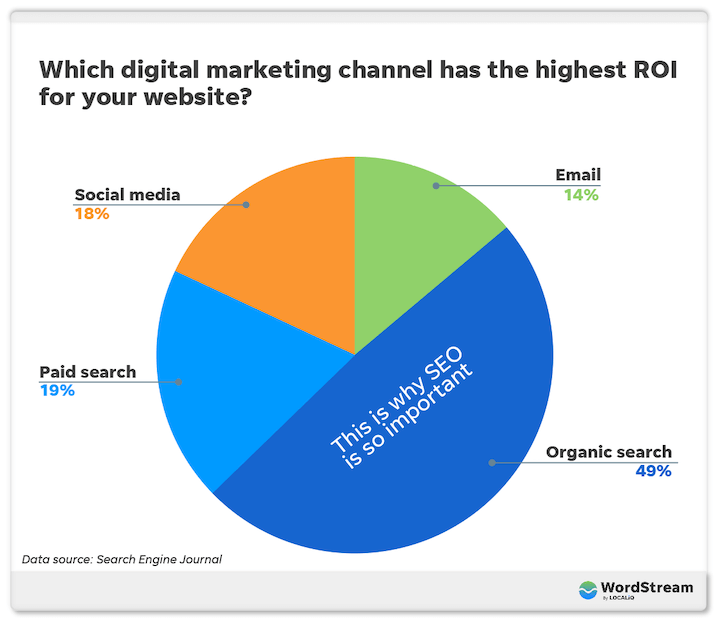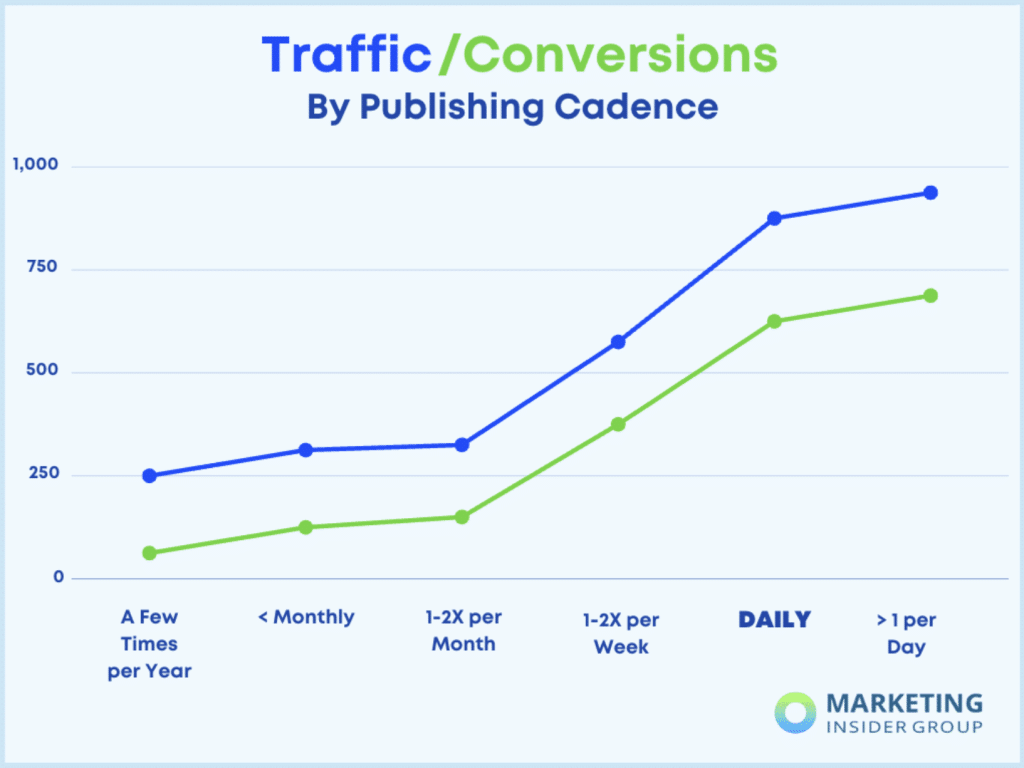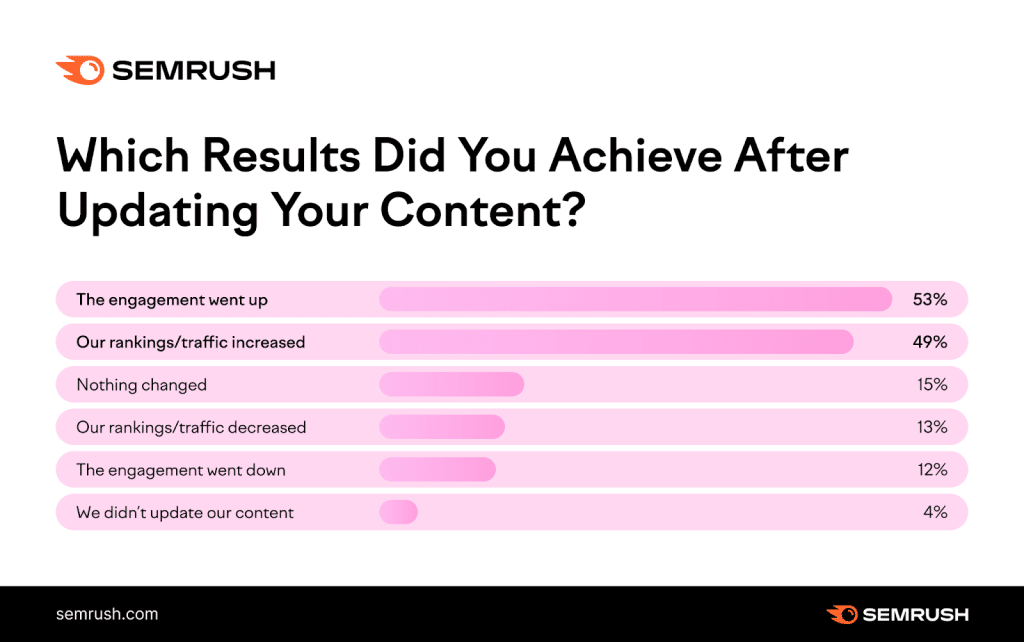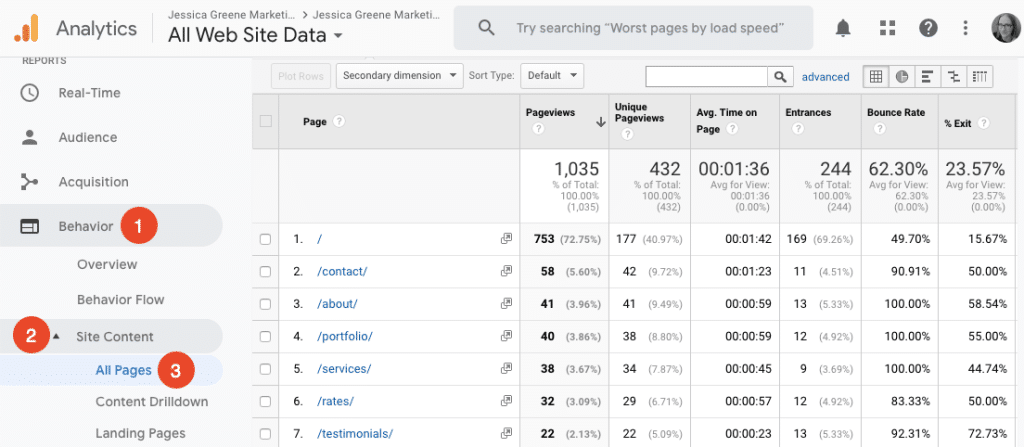
How To Attract Google Search Traffic With Fresh Content
Google holds the reins with over 80% of the search engine market, putting a spotlight on user experience in its ranking playbook.
If your site serves up content that grabs attention, flaunts your know-how, and genuinely benefits the reader, you’re in Google’s good graces. For B2B businesses, this means that keeping your content fresh isn’t just smart—it’s crucial. The fact is that if you publish more often or regularly refresh your content, you’ll master this ranking factor. Having fresh content on your website is good for SEO, but only when the content adequately answers the intent of the search query.
So, what’s the skinny on fresh content and your SEO? How do you keep the content gears turning smoothly? Let’s take a deeper look at the meaning of fresh content, what Google has to say on the subject, and how you can approach freshness as an SEO best practice for your website.
Today, we’re cutting through the noise to highlight fresh content’s role in SEO, its ripple effect on your marketing strategy, and also dishing out practical advice to keep your content engaging.
Quick Takeaways:
- Updating your site with new content signals to search engines and audiences that you’re active and relevant, boosting your SERP visibility.
- Freshness is more pertinent to your SEO strategy if your content is mostly news-related or if you’re in a fast-moving niche.
- Fresh content increases audience interaction and establishes your brand’s authority, which in turn enhances your search rankings.
- Posting new content frequently, like four blog posts per week, significantly increases traffic, underscoring the importance of regular updates for SEO.
- Refreshing old content and embedding relevant keywords boost your site’s SEO, signaling to search engines that your content is up-to-date and relevant.
- You can improve your content strategy by leveraging both evergreen and fresh content – there’s value in both.
What Is Fresh Content?
New or updated content is fresh content. If you’re regularly publishing blog posts and updating old content that has gone stale, you’re improving the freshness of your site.
Freshness makes sense when you really look at the job of search engines. Their objective is to identify valuable, relevant content for searchers. Outdated and obsolete material isn’t relevant.
A website that doesn’t have enough new, fresh posts may see:
- Less engagement
- Higher bounce rates
- Lower rankings
- Search traffic plateaus
You can get a double boost from focusing on freshness.
- First, from the number of updates to your site, which attracts web crawlers.
- Second, from the quality of the updates you make – for example, if you improve the content and garner backlinks from high-authority sites, this could give your content a boost.
The Role of Fresh Content in SEO
Just like how viewers expect to see new stories and updates on the news every day, your audience and search engines expect to see new information on your website regularly. This new information is what we call “fresh content”. This could be anything like:
- Brand-new blog posts
- Articles
- News updates
- Revised landing pages
According to Search Engine Journal, 49% of marketing professionals deemed organic search as their most profitable marketing channel. But in order to reap the benefits of organic search, first you need to rank on SERPs.

Adding fresh content to your website regularly is like telling your audience and the search engines, “Hey, we’re still here, and we’ve got new things to share!” As a result, it keeps your website relevant and improves your visibility on SERPs.
For B2B brands specifically, consistently posting fresh content isn’t just a good practice; it’s a strategic move that can significantly enhance your SEO, increase your visibility, and ultimately drive more business through:
- Improved search engine rankings. Search engines favor websites that regularly update with fresh content. As a result, your site is more likely to achieve higher rankings in search engine results.
- Increased engagement. Fresh content keeps your audience engaged by providing them with new information, insights, and resources. This consistent engagement can lead to higher traffic, more time spent on your site, and more shares on social media.
- Authority and trust. Regularly publishing high-quality, fresh content helps establish your brand as a thought leader in your industry. This can build trust with your audience and search engines alike, which can boost your search engine rankings.
- Keyword optimization. Each new piece of content is an opportunity to weave in relevant keywords that your target audience is searching for. This can help you rank higher for those specific search queries.
- Link building. Fresh content can attract more backlinks from other websites. These backlinks are a key factor that search engines consider when ranking websites. In fact, the #1 result on Google has an average of 3.8x more backlinks than positions #2-#10. So, the more high-quality backlinks you have, the better your SEO.
However, freshness isn’t always going to help your content rank well. As Google’s Matt Cutts explains, regularly updating the pages on your site isn’t something that will automatically help your site rank higher.
Google uses over 200 ranking factors in its algorithm. Freshness can be an important factor, particularly if you’re in a niche where your audience is looking for timely content, such as a news site or a fast-moving industry such as video games or cloud services.
But, for most brands, freshness isn’t that big of a deal. What matters more when it comes to SEO best practices is producing quality content that is relevant to your audience.
In fact, for a lot of topics, the evergreen factor is more important than how often you update the content. To leverage content freshness for your website, it’s important to understand what type of search queries might get a ranking lift from freshness and which should be viewed as your evergreen stars.
The Significance of Fresh Content
Search engines, like Google, have a preference for new and updated content.
When a website regularly publishes new articles, modifies existing ones, or adds new resources, it signals to search engines that the site is active and current.
Audience Engagement
Fresh and frequent content also plays a pivotal role in audience engagement.
Regular updates provide a continuous stream of new information for your audience, encouraging repeat visits and increased interaction.
This not only helps to establish your brand as a trusted authority in your field but also improves your search engine rankings.
The Importance of Frequency
The impact on SEO isn’t just about having fresh content; the consistency of updates is equally as important.
A recent study shows that companies publishing at least 4 blog posts per week saw 3.5 times the traffic compared to companies publishing only once per week.

Regularly updating your site indicates reliability, which search engines value highly.
Opportunities for Keyword Integration
Each new piece of content presents an opportunity to incorporate relevant keywords, which can improve your visibility for specific search queries.
Just keep in mind that the goal isn’t to overload your content with keywords, but rather to seamlessly integrate them into high-quality, engaging content.
How To Post Fresh Content Consistently
You’re probably wondering, “How am I going to find the time to crank out fresh content consistently?”
The truth is that posting fresh content consistently is manageable when you have the right tool and strategy in place. Here’s a few key strategies that can help keep your content fresh and improve your SEO, while minimizing your time commitment.
1. Update Old Content
Your content can become outdated or irrelevant over time, and search engines like Google reward content that’s current and provides value to users.
Updating and republishing outdated blog posts with new information and images can increase organic traffic by as much as 106%. In fact, 53% of marketers reported an increase in engagement, while 49% saw an increase in traffic.

Image Source: Semrush
By updating old content, you’re not only improving its relevance, but also signaling to search engines that your site is active.
Here’s how you can get started:
- Identify content for updates. Start by identifying which pieces of content could benefit from an update. These could be articles that are outdated, have declining traffic, or no longer align with your current business goals.
- Add new information. Once you’ve identified the content, look for ways to add new information. This could be recent industry developments, updated data, or new insights that weren’t available when the content was first published.
- Revise outdated information. Remove or revise any information that’s no longer accurate. This could be outdated statistics, old product information, or broken links.
- Improve SEO. Take this opportunity to improve the content’s SEO. This could involve adding relevant keywords, improving meta descriptions, or optimizing images.
- Republish. Once you’ve updated the content, don’t forget to republish it. This will bring it back to the top of your blog or news feed, giving it more visibility.
Not only does this process keep your content relevant and improve your SEO, but it’s also a lot quicker than creating fresh content from scratch.
2. Make a Content Calendar
A content calendar is a schedule that outlines when and what you’ll publish in the future. It’s a vital tool for planning your content strategy and making sure that you’re regularly publishing new content.
Creating a content calendar might seem daunting, but it streamlines the creation process, making your content more efficient and effective. In the simplest terms, all you need to do is:
- Identify and understand your content needs
- Plan your topics
- Schedule your content
- Assign responsibilities
- Track your progress
To follow our step-by-step process for creating a content calendar, read our post on “How to Make a Content Calendar You’ll Actually Use.”
3. Collaborate with a Content Marketing Agency
Creating fresh, engaging content on a regular basis isn’t easy, especially if you have limited resources or expertise in-house.
Content marketing agencies have the expertise and resources your business needs to create high-quality content that aligns with your goals and resonates with your audience. Not to mention, it takes the “create new content” task off your to-do list, giving you more time to focus on other areas of your business.
When you collaborate with a content marketing agency, you can:
- Maintain a consistent flow of fresh content
- Leverage your agency’s expertise
- Boost SEO
- Reach your target audience
- Rely on professional writers

Image Source: Literal Humans
The perks of working with a content marketing agency don’t stop there. Read more in our “What Is a Content Marketing Agency and Why Do You Need One?” article.
4. Use Content Creation Tools
Content creation tools can simplify the process of creating fresh content. They can help you generate ideas, organize your content, optimize your SEO, and even automate the publishing process.
There are a ton of content creation tools out there, each with its own set of features. Here’s a few suggestions:
- Idea generation. BuzzSumo or AnswerThePublic can help you generate content ideas based on popular trends or commonly asked questions in your industry.
- Content organization. Trello or Asana can help you organize your content, track your progress, and manage your content calendar.
- SEO optimization. SEMrush or Yoast can help you optimize your content for SEO by suggesting keywords, analyzing your readability, and providing SEO recommendations.
- Content creation. Hemingway Editor or Grammarly can help in creating visually appealing graphics or ensuring your content is grammatically correct and well-written.
- Distribution. Buffer or Hootsuite can automate the process of publishing your content on various platforms at scheduled times.
Using content creation tools can save you time, improve the quality of your content, and make sure that you’re consistently publishing new content.
5. User-Generated Content
User-generated content refers to any content–text, videos, images, reviews, etc.–created by people, rather than brands.
UGC can be a powerful tool for B2B brands because it adds authenticity to your content and can help build trust with your audience. Plus, it provides a steady stream of fresh content without calling in all of your resources.
Video Source: Inbound Explained
Here’s a few ways B2B brands can leverage user-generated content:
- Encourage reviews and testimonials. Ask your clients to write reviews or testimonials about your products or services. You can feature these on your website or social media platforms.
- Host contests or giveaways. Encourage your audience to create content related to your brand by hosting contests or giveaways. For example, they could share a photo of your product or service in action.
- Feature client stories. Share stories or case studies from your clients. This not only provides fresh content, but also showcases the value of your products or services.
- Create a community. Build a community where your clients can share their experiences, ask questions, and provide advice. This can be a rich source of user-generated content.
Not only does user-generated content provide a unique perspective, but it also builds trust with your audience and keeps your content authentic and engaging.
Leveraging AI and Machine Learning for Content Freshness
AI isn’t just a fancy tool; it’s our insight engine. It analyzes user behavior, search trends, and engagement metrics to predict what content will resonate with our audience. This is the data-driven precision that helps us craft content that’s not only fresh, but also what our audience craves.
Machine learning takes our content strategy from good to great. It continuously learns from our content’s performance, adapting and guiding our strategy to focus on what truly engages our audience. It’s like having a content strategist that never sleeps, constantly fine-tuning our approach based on real-world data.
But how do we actually use these technologies? Here are a few practical applications:
- Content Personalization: AI helps tailor content to individual preferences, ensuring each piece resonates with its intended audience, increasing engagement and loyalty.
- Trend Prediction: By analyzing vast amounts of data, AI can spot emerging trends, allowing us to create content that’s ahead of the curve, not just following it.
- Content Optimization: Machine learning evaluates what content performs best and why, helping us optimize our future content for better engagement and SEO.
- Automated Content Creation: While we’re not letting robots write our blog posts, AI can assist in generating data-driven reports, summaries, and content outlines, speeding up the creation process.
In essence, AI and machine learning are not about replacing the human touch in content creation. They’re about enhancing our capabilities, making sure every piece of content we produce is not just fresh, but also strategically aligned with our audience’s needs and interests.
How to Leverage Freshness to Help Your Content Rank Higher on Google
SEO expert Cyrus Shephard explains that the way Google’s algorithm looks at freshness is highly complex. It takes into account the size of changes made (i.e., a new header vs. changing 3/4 of the body text), which components are altered (comments and date/time tags are not as important as updated body text), and other factors that signal the quality of updates. Not quantity.

So, what can you do to leverage fresh content for SEO?
- Publish new content, but don’t sacrifice quality for frequency. Posting engaging, helpful, relevant content once or twice a week is far more likely to boost your SEO than posting short, thin posts every day.
- Update old content, but do it with purpose. Don’t change the wording or add a new paragraph simply for the sake of changing things around. Fix broken links or clunky writing, go deeper into the subject, work in insights that add value.
- Stay balanced. Evergreen content forms the backbone of your content strategy, which is why marketers focus on building a large library of timeless content. Timely pieces have their place too. This is where you are writing posts, producing videos, or using other types of content to answer search queries for your audience related to what’s going on in the world or in your niche right now.
- Engage readers. Respond to and encourage comments. Create content that’s worth sharing on social media, and that’s useful enough to attract backlinks from authoritative sites in your industry.
- Track, measure, and refine. Look to underperforming content or blog posts that are losing steam to determine which ones to refresh. When you update and improve the content, pay attention to how your content metrics change as a result. These insights can help you understand what works and what doesn’t for your brand.
- Be consistent. Posting regularly can help to build trust with your audience and establish your reputation as a thought leader. This consistency, in turn, can lead to more high-quality backlinks, more engagement, and higher rankings.
Fresh or Evergreen – Examples of Each Type of Content
Google launched the freshness algorithm update in 2011. One of the key takeaways of this update is the Query Deserves Freshness (QDF) concept. The purpose of QDF is to detect whether a search query is trying to access current information or not.
Here’s an explanation of the QDF algorithm:
For some searches, how fresh the content is does matter. For example, if someone is looking for information on the latest winter storm, this season’s design trends, or timely content in their niche, then freshness factors, such as when the content was published, could impact ranking.
What about your brand – what if it’s not in a fast-paced industry?
You still want fresh content. There will always be SEO events that call for timely or seasonal content. A great example is the pandemic. In 2020 and 2021, content producers have been hard at work delving into how the COVID crisis has impacted work, business, and life.
Here’s a video we produced on Weathering the Storm:
We also published a blog post on virtual event strategies in the COVID era, as well as content on remote work, to serve all of our readers who worked from home during the pandemic.
A look at evergreen
Evergreen content remains relevant, useful, and helpful over time. If a searcher is researching a topic that won’t change much from one year to the next, they’re probably looking for evergreen content.
Evergreen topics are, for the most part, constant. For example, how to make a pie crust or how to create a content strategy. The same information is relevant year after year.
However, that doesn’t mean you shouldn’t update your evergreen posts. These topics may not be time-sensitive, but that doesn’t mean some things don’t change. For example, if there’s a new tool that can help someone make a pie crust – or a content strategy – you may want to include it in your post.
It’s also worthwhile to update content to reflect current SEO best practices and to simply improve the writing. Si Quan Ong from Ahrefs suggests tracking the performance of your evergreen content. If your rankings drop over time, that’s a sure sign your content isn’t as relevant as it could be.
When refreshing evergreen content, replace outdated stats, obsolete processes, or insights, and fix any broken or irrelevant links. You may also want to replace visual content that’s outdated, such as old screenshots or videos.
Another step, especially if you’re noticing your old top performers slipping, is to look at the posts that are ranking well for the same keywords your blog post is focused on. What can you do to make yours better?
Measuring the Impact of Fresh Content on SEO Performance
To truly understand the value of our fresh content, we need to measure its impact. By keeping a close eye on certain metrics, we can get a clear picture of how our fresh content is influencing our SEO performance. This data-driven approach allows us to refine our strategy, ensuring our content not only resonates with our audience but also drives tangible results.
Here’s how we break it down:
Tracking Organic Traffic
First things first, let’s look at our organic traffic. It’s a clear indicator of how well our fresh content is performing. If we see a spike in visitors after publishing new content, that’s a good sign we’re on the right track. Tools like Google Analytics can help us monitor these trends and pinpoint which pieces of content are driving traffic.

Image Source: Zapier
Analyzing Engagement Metrics
Traffic is great, but what are visitors doing once they land on our site? Are they sticking around, reading our content, and taking action? Metrics like bounce rate, time on page, and pages per session give us insights into how engaging our content is. The more our audience interacts with our content, the more likely search engines will take notice and boost our rankings.
Monitoring Keyword Rankings
Fresh content gives us the opportunity to target new keywords and improve our rankings. By tracking how our content ranks for specific keywords over time, we can gauge the effectiveness of our SEO strategy. Tools like SEMrush or Ahrefs can be invaluable here, providing detailed insights into our keyword performance.
Evaluating Backlink Growth
Quality content attracts quality backlinks. By monitoring the growth in backlinks to our fresh content, we can assess its impact on our SEO. More backlinks from reputable sites not only boost our content’s credibility, but also improve our site’s overall SEO performance.
Assessing Conversion Rates
Ultimately, the goal of our content is to drive conversions. Whether it’s signing up for a newsletter, downloading a whitepaper, or making a purchase, we need to track how our content contributes to these goals. Analyzing conversion rates helps us understand the direct impact of our content on our business objectives.
Keep Up With Fresh Content Today
When it comes to SEO, fresh content is a must-have. By consistently delivering new blog posts, articles, news updates, and revised landing pages, you signal to both your audience and search engines that your brand is active, informed, and engaged in providing value. Remember, in the world of digital content, staying fresh is staying ahead.
Ready to start posting fresh content consistently? Marketing Insider Group can help. Get started today by checking out our weekly blog content service, or schedule a free consultation now to learn more!







Thanks Michael! Very helpful tips. I was wondering, how often do you suggest we publish a new content?
As often as you can publish quality content for the lowest budget / time. It really depends. but I think shooting for once a day is a great start. I find most companies are surprised that it is not as difficult as it seems if you focus on sharing your expertise.
Thanks Michael for the tips 🙂